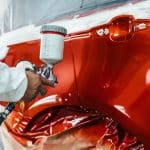Many find the call of adventure irresistible, and off-roading trips are the epitome of outdoor excitement. Off-roading’s increasing popularity is not just about the thrill and overcoming rough terrain—it’s also about bonding with nature and fellow enthusiasts. With their robust build and undeniable swagger, Jeeps have become synonymous with these rugged escapades. We’ll explore the best types of Jeeps for off-roading trips that can turn rocky paths into memorable adventures.
Jeep Wrangler Rubicon
The Jeep Wrangler Rubicon rules the off-roading kingdom and for good reasons. Built with a trail-ready stance, it boasts heavy-duty Dana 44 front and rear axles, a 4:1 low gear ratio that allows for more controlled descent on steep terrain, and electronically locking differentials that ensure consistent traction.
What separates the Rubicon from the pack is its Rock-Trac® 4×4 system, providing a “rock-crawling” mode that can handle boulders and logs effortlessly. With a ground clearance tailored for high elevations and its sway bar disconnect feature, the Rubicon offers unrivaled articulation and obstacle crossing. With this powerful vehicle, you’re ready to take on the best off-roading trails in the US.
Jeep Wrangler Willys
A devotion to the original WWII-era design, the Jeep Wrangler Willys is a tribute to Jeep’s military heritage with a modern twist. This Jeep comes with special shocks, rock rails, and a limited-slip rear differential—features that give the Willys the grit to conquer muddy, sandy, or snowy terrains with tenacity.
The Wrangler Willys does not compromise aesthetics for ability. It also comes outfitted with aggressive-looking 32-inch mud-terrain tires that are as functional as they are visually imposing, providing the grip and resilience off-road enthusiasts can rely on.
Jeep Grand Cherokee Trailhawk
You get the Jeep Grand Cherokee Trailhawk if you want an off-roading vehicle that marries refinement and ruggedness. It’s a full-bodied SUV designed to provide comfort during the long drive to the trail and the capabilities needed upon arrival. Its Quadra-Lift® air suspension system elevates for additional ground clearance. At the same time, the Quadra-Drive® II with a rear Electronic Limited-Slip Differential (ELSD) ensures it delivers maximum torque to the wheels that need it most.
The Trailhawk carries a unique blend of luxury inside with robust performance outside, allowing for a smooth transition from urban landscapes to untamed environments.
Jeep Gladiator Mojave
Many people wonder: Is a Jeep or a truck better for off-roading? Enter the Jeep Gladiator Mojave for those who need a mix of utility and off-roading prowess. You can blend the best of both worlds with this vehicle. This beast features a reinforced frame, a one-inch front suspension lift for added clearance, and FOX™ 2.5-inch internal bypass shocks with external reservoirs to handle the intense heat and relentless bumps of desert off-roading.
The Gladiator Mojave is not just about muscle; it’s about sustainability on the trail, leveraging its strength in the harshest terrains but ensuring all paths remain unscathed for fellow adventurers.
The best types of Jeeps for off-roading trips means looking for one that aligns with your adventure spirit and the terrain you plan to conquer. While the Wrangler Rubicon, Wrangler Willys, Grand Cherokee Trailhawk, and Gladiator Mojave each cater to different niches, they all ensure your off-roading experience is nothing short of extraordinary. Now, check the tires, pack your gear, and hit the trails with confidence and excitement aboard your mighty Jeep.













Leave a comment